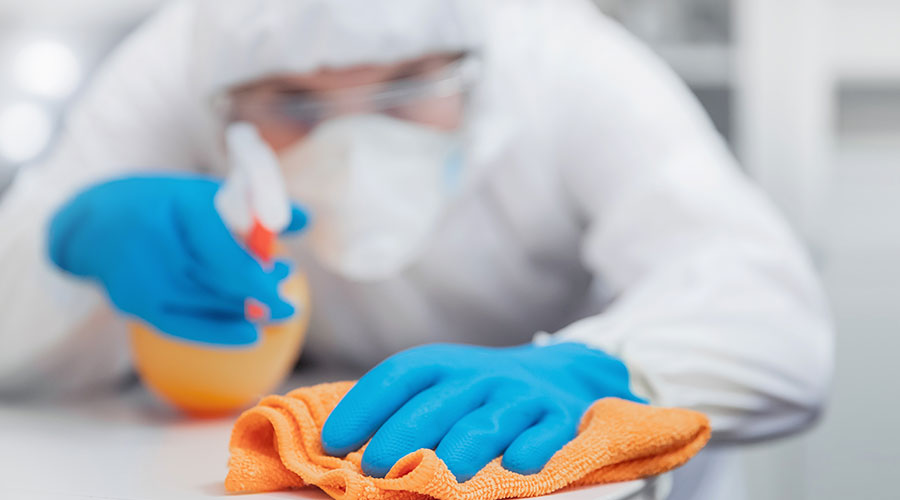There is increasing recognition that wet-surface and dry-surface biofilms play key roles in the effectiveness of cleaning and disinfection protocols in healthcare facilities. Wet or moist areas — including drains, faucets and showers — and reusable devices such as flexible endoscopes can develop wet-surface biofilm. Dry-surface biofilm develops on some medical devices and on dry environmental surfaces, including computers and tablets.
These biofilms are ubiquitous in healthcare facilities and act as reservoirs for microbial transmission to patients that can lead to infection (Maillard 2023, Ledwoch 2022). When wet-surface or dry-surface biofilms contain multi-drug-resistant organisms (MRDO), it is crucial for a healthcare facility to have protocols that restrict the spread of such pathogens. It also is essential to understand the general transmission of microorganisms in a facility, as well as the role of biofilms in the transfer of microorganisms to patients and how to prevent or remediate these reservoirs.
Biofilms can occur in sinks and drains. The parameters to consider for infection prevention and control of these biofilms are microbicidal effect: reducing microbial burden — specifically MDRO — reassigning biofilm mass and regrowth. The challenges for this biofilm are sub-optimal microbicidal activity, a limited window for interventions, sink location and use, rapid regrowth of identical biofilm, no standard efficacy test protocol and a limited number of standard tests in the United States.
Dry-surface biofilms can be present on surfaces near patients. The parameters to consider in infection prevention and control for these biofilms are selecting a disinfectant with a biofilm kill-claim, preventing transfer, ensuring the surface is safe and detection. The challenges for this biofilm are detection, an effective combination of removal or microbicidal efficacy and no standard efficacy test protocol.
Effective cleaning and disinfection depend on the right product, the right process and an educated and trained cleaning professional. Challenges faced by healthcare facilities in maintaining environmental cleanliness include:
- existing design constraints
- materials and equipment that are difficult to clean
- appropriate time to clean and disinfect surfaces and equipment
- chemical compatibility
- quality measurement standards.
Having a team of well-trained environmental services personnel is a vital element to effective cleaning and disinfecting. Cleaning and disinfecting require meticulous and systematic task management using the correct technique to clean and disinfect each environment or piece of equipment. Training programs and standard operating procedures should clearly identify roles and responsibilities to ensure all surfaces and equipment are cleaned and disinfected by the appropriate staff member.
Ensuring that all spaces and equipment have a staff member assigned to clean and disinfect them contributes to a reduction in environmental reservoirs harboring microbes. Managers should allocate sufficient time for workers to complete each task thoroughly so surfaces are well cleaned, disinfectants are applied correctly and surface contact times are achieved.
J. Darrel Hicks, BA, MESRE, CHESP, Certificate of Mastery in Infection Prevention, is the past president of the Healthcare Surfaces Institute. Hicks is nationally recognized as a subject matter expert in infection prevention and control as it relates to cleaning. He is the owner and principal of Safe, Clean and Disinfected. His enterprise specializes in B2B consulting, webinar presentations, seminars and facility consulting services related to cleaning and disinfection. He can be reached at darrel@darrelhicks.com, or learn more at www.darrelhicks.com.

 Grounding Healthcare Spaces in Hospitality Principles
Grounding Healthcare Spaces in Hospitality Principles UC Davis Health Selects Rudolph and Sletten for Central Utility Plant Expansion
UC Davis Health Selects Rudolph and Sletten for Central Utility Plant Expansion Cape Cod Healthcare Opens Upper 2 Floors of Edwin Barbey Patient Care Pavilion
Cape Cod Healthcare Opens Upper 2 Floors of Edwin Barbey Patient Care Pavilion Building Sustainable Healthcare for an Aging Population
Building Sustainable Healthcare for an Aging Population Froedtert ThedaCare Announces Opening of ThedaCare Medical Center-Oshkosh
Froedtert ThedaCare Announces Opening of ThedaCare Medical Center-Oshkosh